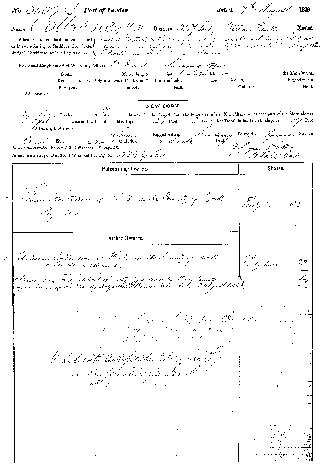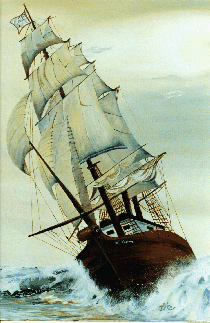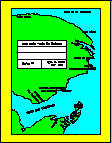Navigating the Lower Saint Lawrence in the 19th Century.
Wreck of the Bark COLBORNE October 15, 1838 | ||
|---|---|---|
|
The earliest documented evidence of the bark Colborne dates back to Saturday, May 19, 1838, around 11:00 AM, when she was launched at the Shaey and Merritt shipyard just below ST. Mary's Current in Montreal. Build for William Collinson and Isaac Whitaker of Kent, England, co-owners, she was certified by the Montreal Collector and Controller June 4th, 1838. After an uneventful crossing, she arrived at London, where she loaded a general cargo including wines, spirits, sperm oil, specie and numerous other less known items, plus military goods. On August 7th, she was granted a Certificate of Registry  10,
under the name of Colborne of Hull, at a burthen of 347 tons.
From the new form by the Board of Surveying, London, we learn she was 102
feet in length, 24 feet wide with a hold of 17 feet deep. Rigged with a
standing bowsprit, a square stern, carvel built with no gallaries and a
scrolled head, she was admeasured at 324 2/94 tons by the latest method
of calculation.
10,
under the name of Colborne of Hull, at a burthen of 347 tons.
From the new form by the Board of Surveying, London, we learn she was 102
feet in length, 24 feet wide with a hold of 17 feet deep. Rigged with a
standing bowsprit, a square stern, carvel built with no gallaries and a
scrolled head, she was admeasured at 324 2/94 tons by the latest method
of calculation.
The Colborne cleared London Thursday, August thirtieth, 1838, bound for Quebec and Montreal. According to the protest 9 recorded by notary Martin Sheppard October 24th, she was reported as being "tight, staunch and strong and in all respects in good order, well and properly manned, victualled and apparelled for, and her hatches well and sufficiently caulked and covered" when she left London. Nothing extraodinary happened during the crossing, until the night of the 15th and morning of the 16th of October, 1838, when she struck the rocks at Pointe Maquereau, County Bonaventure in the Chaleur Bay. 
While her forefoot and part of the keel were soundly grounded on the rocks, the stern floating free in 15 fathoms. In attempting to refloat the fore section, she again struck heavily on the rocks, carrying away her rudder and part of her stern post. The second mate was washed overboard while cutting away the masts, which fortunately saved his life. With heavy seas washing over the vessel, the crew were unable to land. Captain Kent and the chief mate were washed overboard and drowned. In the morning, the Colborne fell over on her beam ends, when over forty of the crew and passengers went to their watery graves. With considerable difficulty, the remainder succeeded in getting on shore about three miles east of Pointe Maquereau in the long boats. At Port Daniel, they hired two schooner to tow her into a place of safety, but only succeeded in getting the Colborne to Harrington Cove, about two miles east of Port Daniel. A considerable amount of valuable cargo was saved both by the crew and shore people, and stored with the Magistrate, to be sold by auction. From the cargo survey 8 also dated October 24, 1838, conducted under the order and instruction of the Court of Bonaventure, we learn that the cargo was strewn along the coast and even got across the Chaleur Bay to Caraquet. On the same day, a Power of Attorney 11 was authorized by the second mate, Alexander Mavor, but the first microfilmed page is badly damaged and barely readable. Luckily, the 1983 student project 22 project on the wreck of the Colborne provides us access to the copy filed at the Bonaventure Court House, although some loss has occurred in translating it back into English. Luckily, the second page came out quite clear. However, the next day, a deed of resiliation 12 was passed revoking that Power of Attorney. The next five deeds cover the surveys mandated by the Majestrates at the Her Majesty's Court in Bonaventure on the recovered cargo. While the format is somewhat repetitious, each deed brings out items few are unfamiliar with. While the first deed #546 13 mentions only one bale of drawers and two boxes of books, deed #547 14 includes four bales of clothes, a quanity of sail, one hogshead G of gin, a bale of silk, a hogshead of wine, one pipe G of high wine G , olive oil and palm oil were recovered and stored on the west side of Port Daniel River beach. But what is a hogshead or a pipe of wine, or even high wine? With so many little known terms and items turning up in the various deeds, I've included a glossary where you can check them out. The highlighted superscript letter G will follow anything thats unfamiliar to the most of us, and, as to the ones I still haven't clarified, they are up for grabs. If you have a reliable documented reference that clearly identifes the term or item, e-mail me at: In Martin Sheppard's notary deed #548 15 I was somewhat intrigued by what the surveyors reported. I never before heard or read of merinos G , long ells G or pea jackets G , but between the glossory included with the 1983 student 22 study, and all the dictionaries I could lay my hands on, I'm a little more enlightened. How about you? The next deed, #549 16 doesn't enrich our vocabulary, but confirms that gin remained one of the major imports from the U.K and West Indies during the first part of the 19th century. A few terms of deed #550 18 took me more than a few minutes to locate. "Schiedam" G turns out to be a brandy produced in Schiedam, Holland. "Flushing" G remains a mystery, as far as dictionaries go, but the French definition included in the student study 22 is quite clear, as long as you can read and understand French. while "rateen" G appears with several different spellings and doesn't appear in any of the English dictionaries I have. However, the 1983 French glossary I mentioned above, gives us "Ratine": (ratteen) étoffe de laine croisée dont le poil est tiré au dehors et frisé." The inspection and ship survey found in deeds #551 19 adds little to what we already know, but confirms that the tide flowed in and out of one side of the Colborne as she had been scuttled both on the side as well as on deck, in order to remove portions of the cargo. The surveyors further mention she was a total wreck, with no chance of refloating from her present position. From the damage sustained and exposed situation where the vessel was imbedded between rocks, plus the advanced season, they recommended she be auctioned off at the earliest moment for the benefit of all interested parties. In the last of the surveys of part of the cargo saved from the Colborne, two terms appear in deed #552 20 that are used in many 19th century newspaper articles covering the import-export trade between the U.K. and Canada. A "ullage cask" G is the quantity missing to fill a container, while a "tierce" G , a variant of "terce", is a third, as in a third of a barrel or cask. The following pages includes numerous facts and details on the wreck of the bark Colborne as found in the Quebec Gazette. | ||
| G.R. Bossé©1998-03. | Posted: Nov. 1, 1998. |
Updated: 15 July, 2003. |
